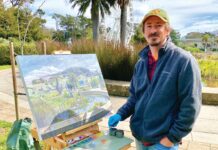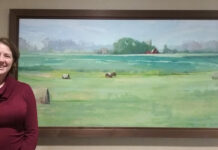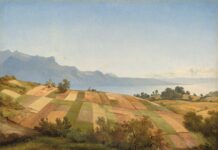
After years of painting, with sales and some success, Lennie Mullaney was told that she “had no idea how to paint.” It was strong medicine, a little bit tough to swallow.

“Red Cranes,” by Lennie Mullaney, 2012, oil, 48 x 46 in.
The critique came at a crucial time and in a crucial place. Mullaney lost her husband to illness and realized she wanted to rework her life in the face of this loss. She sold her house in Maine, gave notice at her longstanding teaching job, and decided to pursue art full-time. She found a program in 2009 in Italy, the International School of Painting, Drawing and Sculpture, in Montecastello di Vibio (now closed). A visiting instructor there from the School of the Art Institute of Chicago, Dan Gustin, was the bearer of the tidings about her painting skills. “I could pull off a painting pretty well,” says Mullaney. “I had a certain formula that worked for me. But the professor said I hadn’t a clue. He told me to stop making pretty pictures and learn how to see. ‘You have a formula that you pull out of a hat like a rabbit trick,’ he said.”

“Yellow Truck,” by Lennie Mullaney, 2011, oil, 32 x 48 in.

“Sarah Long: Wetlands,” by Lennie Mullaney, 2013, oil, 30 x 40 in.
Mullaney came back to her new home in New Hampshire and tried to enroll in the University of New Hampshire to earn her Master of Fine Arts degree. No go. They questioned her stamina. They questioned whether a seasoned teacher could take instruction from younger instructors. Mullaney did not take no for an answer; she enrolled in UNH’s continuing education program and proved to the administrators that she was capable, serious, and open about graduate studies. When she applied the following year, Mullaney was accepted into the two-year program.

“Blue Water,” by Lennie Mullaney, 2012, oil, 48 x 46 in.
“I had to talk my way into the school,” says the artist. “And I had to unlearn a lot of what I had learned. For two years, I was painting seven days a week, and I was having a ball. I received the same criticism at UNH that I got from Gustin, and I had to concentrate on making paintings that were painterly — not just pretty pictures, but paintings in which I considered every area of the canvas important. It was not about foreground, middle ground, background. It was shape, color, movement. Painting is about relationships, tonal comparisons, relationships between values, between shapes, and a variety of mark-making. I studied art history, I did drawings, I concentrated on becoming an observational artist. One of my teachers said, ‘You are forbidden from painting anything coastal or pastoral. You will just fall back on your formulas. Paint something else.'”

“Morning Commute: Memorial Bridge,” by Lennie Mullaney, 2013, oil, 24 x 30 in.
For her MFA thesis exhibition, Mullaney painted the deconstruction and reconstruction of the Memorial Bridge, which links Portsmouth, New Hampshire, to Kittery, Maine. “It was a found still life that wasn’t still,” says Mullaney. “I realized when painting it that I couldn’t control this. Whatever was going on in the construction is what I was going to paint. It was urban, in a state of chaos. It took away the safety net of painting beautiful fields and red barns and my grandmother’s farm. It was very liberating. By painting something that was really difficult, I had to look at the shapes and how they related. Also, it was a spiritual metaphor, as I was rebuilding my life.”

Mullaney working on location
Mullaney asserts that every painting is abstract, and most representational painters will agree that an abstract design is the basis for all pieces. Mullaney stresses that “it’s all abstract. It’s a flat canvas. I used to draw and fill it all in. Now I concentrate on all parts relating to each other and to the whole, on relationships. One instructor had us create a painting where we couldn’t name any color used, because we mixed each of them ourselves. You become much more aware of the relationships that way. Many canvases and drawings later, I began to understand what they were talking about.”

“No Parking,” by Lennie Mullaney, watercolor. An example of the artist’s work before earning her MFA
She earned her degree in 2012 and is now painting full-time and putting to work all that she has learned — and approaching what she has always loved with fresh eyes. “I love plein air painting, and who doesn’t enjoy a beautiful scene?” says Mullaney. “I’m always outdoors, and I’m always looking at the way light hits a landscape. But now I also love a grittier urban landscape. I particularly like something in a state of disassembly. We modify the world around us, and sometimes that means we make a more utilitarian building, not built to be attractive. But they are interesting shapes!”

“Monhegan,” by Lennie Mullaney, pastel. Another example of her work before earning her MFA
Mullaney goes on, “The whole experience of going back to school tore away a lot of the conventions about how I create art. Now I can pick and choose how and when I want to use some of those conventions.”





I love the idea. Congratulations.